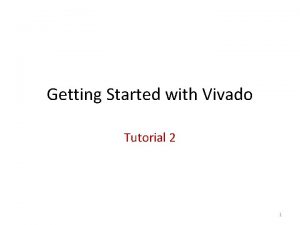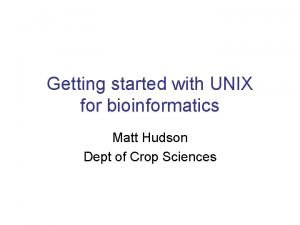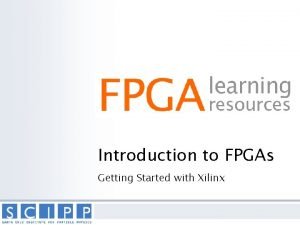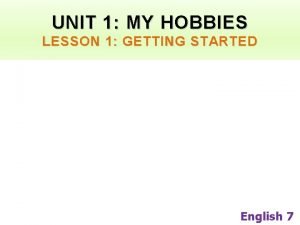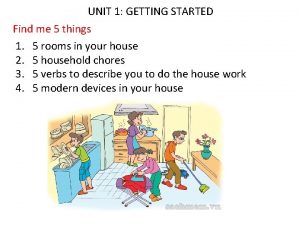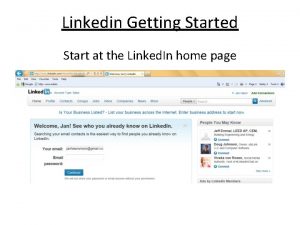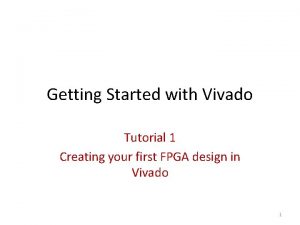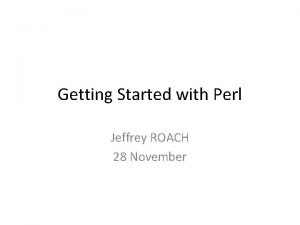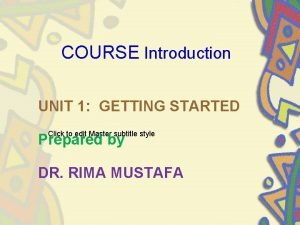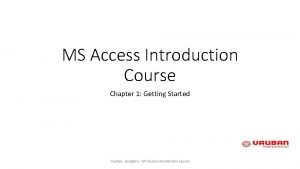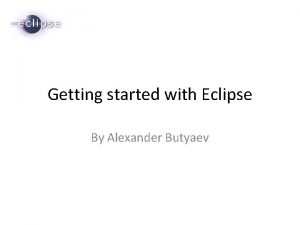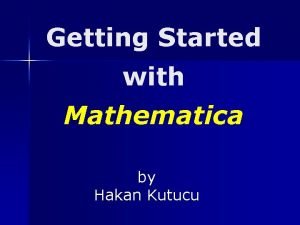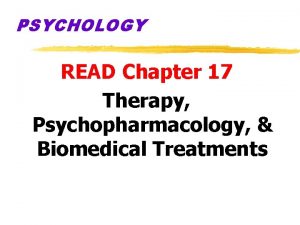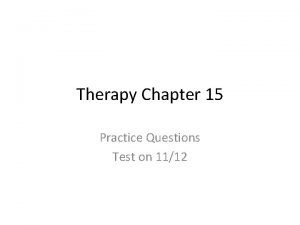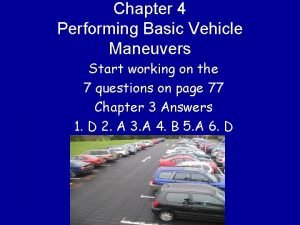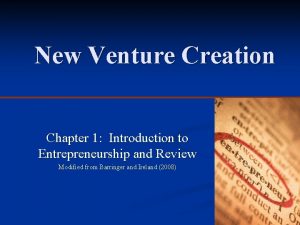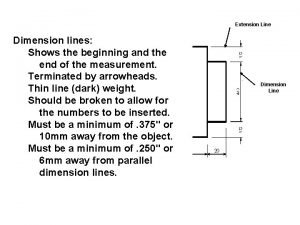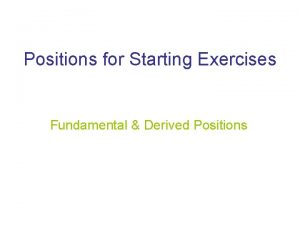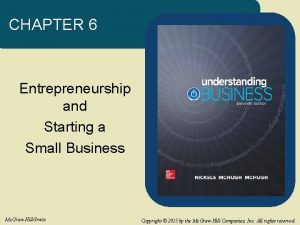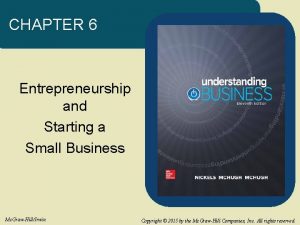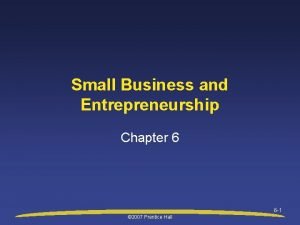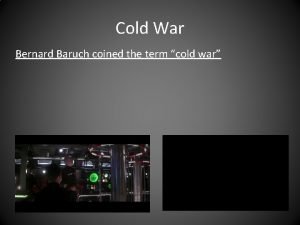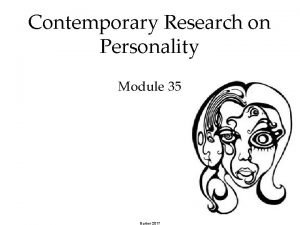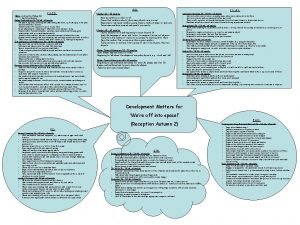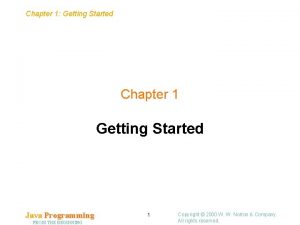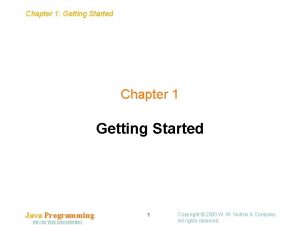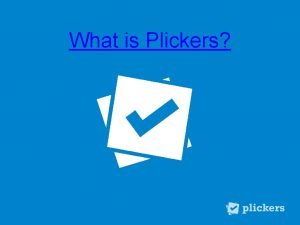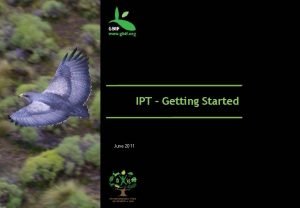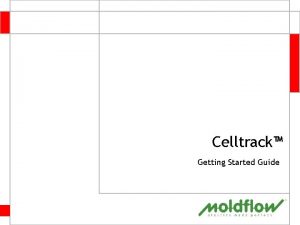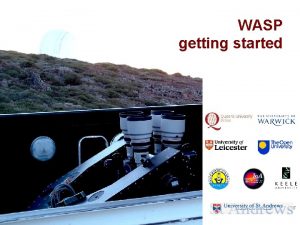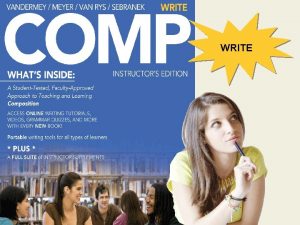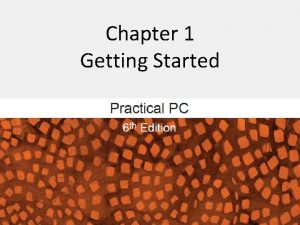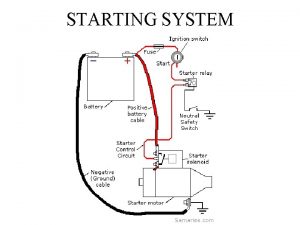Getting Started and Starting to Play Play Therapists






































- Slides: 38

Getting Started and Starting to Play: Play, Therapist's Stance and the Beginning Phase of Therapy Efrain Bleiberg, MD ebleiberg@menninger. edu 1

Focus on engaging children in a therapeutic relationship that gives access to children's inner world of subjective experience. (How they organize sense of self, relationships and the world, their struggles, worries, conflicts and anxieties and how they seek to cope and manage their struggles, worries, conflicts and anxieties. ) 2

n Inner world mediates between 1) biological vulnerabilities and environmental adversity, on the one hand, and behavior, symptoms and adjustment, on the other hand 2) ability to use treatment to consider change (therapeutic alliance). n Dynamic point of view: behavior is based on mental states (thoughts, feelings, wishes, beliefs, misperceptions) that give direction and meaning to behavior. 3

Play as the path to children’s inner world 4

OBJECTIVES n n n To discuss the developmental and therapeutic functions of play, particularly as a mechanism to generate symbolic – representational capacities and reciprocal relationships. To review what therapists do to get therapy started and promote symbolic, reciprocal play (promoting an alliance and the “stance” of therapist). To recognize when playing (and the alliance) breaks down and how to help bring it back (basic aim of dynamic therapy). 5

SIGMUND FREUD’S DEVELOPMENTAL PERSPECTIVE Early development shapes adult relationships, coping (defense) mechanisms, and the overall capacity to work, love and find gratification n Neurotic conflicts and psychopathology recapitulate earlier (infantile) modes of functioning to which the person regresses and/or is “fixated” n 6

PSYCHODYNAMIC TREATMENT AIMS AT PROMOTING DEVELOPMENT n Designed to enable patients to free themselves from being “stuck” in the past and to “push” them in the direction of their own development 7

8

Why evolution has conserved - and made so compelling, absorbing and fun – an activity free of external goals and pressures? n Practice of curiosity, exploration, flexibility, novelty – seeking, creativity 9

HYPOTHESIS Play evolved to facilitate the development of symbolic – representational processing, perspective – taking and social reciprocity (twoway social relationships) n From automatic, implicit, procedural search for matching to controlled, explicit, symbolic search for coherence n From closed system with a single perspective to open system with multiple perspectives n From coercion and manipulation to reciprocity and give – and – take 10

ATTACHMENT n n n Innate disposition to seek proximity, form emotional ties and evoke protection, regulation and reciprocity Attachment is activated by pre-programmed cues signaling threats to survival Threats to infant’s survival activate affect as a procedural signal evoking protective, regulating, reciprocal response from a caretaker disposed to interpret the infant’s affective signal 11

Baby’s brain prewired to recognize and seek out a match between procedural signal and environmental outcome (contingent relation: “A” precedes “B” and “B” follows “A”) Bigelow & Rochat, 2006 Gergely & Watson, 1996 Gergely, 2004 12

n Evoking a contingent “match” as the basis of the procedural sense of self as agent n Evoking a contingent match as basis of internal working models of the self as effective and others as responsive, underlying secure attachment 13

THE PROTOTYPE OF TRAUMA n Brain evolved a pre-wired encoding of survival of the self as predicated on another person’s contingent, procedural, matching response. Pre-wired (narcissistic) vulnerability triggered by absence of contingent response from others 14

Lack of reciprocity (non contingency) is a signal of threat to survival and evokes fight-freezeflight 15

Mirror Neurons 16

Implicit / Automatic / Procedural Processing Seeks affective / motoric / perceptual (procedural) match between one’s mental states and other people’s mental states n What I know, everyone knows, what other’s know, I know n Match is achieved through actions (manipulation) n Generates psychic equivalence n 17

PROCESSING SELF vs OTHERS n Two distinct neural networks are shared for selfmentalizing and mentalizing others. Ø A fronto-parietal mirror-neuron system activated by motor simulation mechanisms (Gallese, Keysers, and Rizzolatti, 2004; Rizzolatti, and Criaghero, 2004) and activation of viscero-motor centers for affect understanding Ø Key evolutionary mechanism underpinning social empathy: knowing others from the inside by an implicit, procedural, automatic system providing other-to-self and self-to-other mapping Ø Conflates the embodied, procedural self and other experiences 18

CONTINGENCY DETECTION, NARCISSISTIC WELL BEING, SOCIALCOGNITIVE PROCESSING (MENTALIZING) (MENTALIZING Beginning of Mentalizing and Subjectivity 2: Order Representation of Internal States Co n Ma ting rke ent d, , At Re tu sp ned on se , Mentalizing Constitutional Self: Attachment-Seeking, Contingency-Detecting Temperament & Innate Basic Emotions Baby Sig l na Resonance Caretaker 19

CARETAKER’S RESPONSE PROMOTES DEVELOPMENT OF EXPLICIT/SYMBOLIC MODE OF SUBJECTIVITY n Mismatch (2/3 of the time) attuned match effort to find the “right” contingent, n Attunement (1/3 of the time) is conveyed by displaying the procedural aspects and qualities of the infant’s internal state (the “architecture” of the internal state, D. Stern) re: affect quality, arousal level, tempo. This display, however, is expressed in a different behavioral mode (no imitation) n Attuned display is marked by communicative cues such as eye contact (Farroni, et. Al. , 2002); “Motherese” (Fernald, 1992; Cooper and Aslin 1990); High contingent-reactivity (Movellan and Watson, 2002); Empathic affect-mirroring (Bigelon, 1999; Gergely, 2004, 2007) that promote attention and learning in the infant the pedagogical mechanism 20

CARETAKER’S RESPONSE PROMOTES DEVELOPMENT OF EXPLICIT/SYMBOLIC MODE OF SUBJECTIVITY cont. n Attuned and marked displays promote uncoupling of overt behavior and internal state n Contingency-detection mechanism associates caregiver’s display (“This display is not my real internal state but my interpretation of your internal states) – contingent social feedback of the caregiver’s representation of the infant’s basic emotional state and the infant’s own procedural emotional state, promoting second order representation of internal states that makes them accessible to introspection, subjective experience and differentiation 21

Baron-Cohen’s (2005) model of the social brain The Intention Detector The Emotion Detector - Left inferior frontal gyrus - Mirror neurons - Right medial prefrontal cortex - inferior frontal cortex - Bilateral anterior cingulate - Superior temporal gyrus Eye Direction Detector - Posterior superior temporal sulcus Shared Attention Mechanism - Bilateral anterior cingulate - Medial prefrontal cortex - Body of caudate nucleus The Empathizing System - Fusiform gyrus - Amygdala - Orbito-frontal cortex EMOTION UNDERSTANDING Theory of Mind Mechanism - Medial prefrontal cortex - Superior temporal gyrus - Temporo-parietal junction BELIEF-DESIRE REASONING 22

PROCESSING SELF vs OTHERS n n n Developmental need to learn what is “me” as distinguished by what is assumed to be shared Second system: anterior front-medial cortex, anterior cingulate cortex and the temporo-parietal junction areas involved in explicit / controlled mentalizing (perspective taking, self-referential processing, selfagency (Brass et al, 2005; Brass, and Haggard, 2008; Aichorn et al, 2006; Frith and Frith, 2006) inhibits automatic matching Sequence: initial imitative matching within mirror system interacts with the reflective, explicit / controlled mentalizing system to reduce and modulate the mirror system and the extent of primary identification (psychic equivalence) with the other 23

EXPLICIT/SYMBOLIC MENTALIZATION (Controlled) * Declarative/Episodic/Semantic * Representational/Autobiographical Narrative * Conscious/Preconscious/Unconscious “Pretend Mode” *Gallagher & Frith Trends in Cognitive Sciences 7: 77 -83, 2003 Group data mapped on to a template brain 24

EXPLICIT / CONTROLLED / REPRESENTATIONAL Puts the brakes on matching: Effortful control of attention and the perspective of separate minds n Separation of the representation (mental model) and the procedural experience n 25

Explicit / Controlled / Representational Processing n n n Stored as explicit (episodic, semantic) memories Conscious or potentially conscious Generates representations organized with the narrative structure of a story – seeks coherence Can be verbalized “Extracts” themes and meaning from episodic memories to generate semantic memories Autobiographical narrative 26

Processing Implicitly & Explicitly n Implicit/Automatic Perceived/Felt/Acted Emotional Resonance Empathy (Match) Non conscious Procedural Non verbal n Non Reflective n n n n Explicit/Controlled Interpreted Explained Perspective Conscious (or potentially conscious) Can be verbalized n Reflective (coherence) n n Functional integration at age 4 dissociation under arousal (flight – or – flight) 27

Developmental Functions of Play n n Play: Straddling more than one self-state, entertaining multiple perspectives (self-other) Play: Ø Release tension Ø Master trauma Ø Engage and attach Ø Experiment with coping Ø Practice perspective – taking Ø Integrate self - states Ø Negotiate self - other relationships 28

PLAY IN PSYCHODYNAMIC CHILD THERAPY n n n The play’s the thing (J. Frankel, 1998) Psychodynamic psychotherapy and psychoanalysis as “highly specialized forms of playing in the service of communication with oneself and others” Winnicott (1971) pp 41 A central function – and key therapeutic mechanism – of psychodynamic child psychotherapy is to promote children’s capacity to engage and generate reciprocal, symbolic play (give- and – take; coherent narrative, attitudes of openness to novelty and learning, tolerance of not knowing, curiosity, multiple perspectives, flexibility, empathy, agency 29

HOW TO GET STARTED: THERAPIST’S STANCE n Establishing rapport: ØCommunicate interest and intent: “this time is set aside to play and talk so we can make sense of what bothers you; so you can deal with what bothers you more effectively” ØThe child leads the way and therapist’s accepts and validates and provides structure and containment that makes playing and expressing feelings safe (see Dugan in segment #3) “the rules of playing”: time frame, can not hit, hurt the setting or therapist or self 30

HOW TO GET STARTED: THERAPIST’S STANCE n The inquisitive stance Ø Ø Ø n Inquiring Respectful Curious Engaged Tentative Therapists communicates that understanding feelings (our own and the feelings of others) is important, including what those feelings might be and the thoughts, meanings and related experiences attached to them. Conveys interest and openness to see things from child’s perspective: “is this how this looks like / feels like it (in the play or to you); ” “did I get it right” “I can see why”. Spot Tim Dugan taking this stance. 31

Segment No. 1 32

HOW TO GET STARTED: THEAPIST’S STANCE n n n Recognize and reflect – in an inquiring, respectful, curious, tentative way – the feelings, thoughts, meanings and related experiences suggested by the play – tolerate not knowing “madness is the need to believe and be believed” Winnicott; the certainty of a closed system Check: Does the child and play become freer, more communicative (verbally and non-verbally) reciprocal, elaborate? Or does it break down (see turning off the lights) and child and play becomes more restricted, fragmented, aggressive, coercive, avoidant? Aim: facilitate children’s recognizing and expressing in words or play their anxieties, conflicts, feeling, thoughts 33

HOW TO GET STARTED: THERAPIST’S STANCE n n n Natural, not too clever Uses simple, brief, jargon – free, developmentally – appropriate, non-patronizing interventions: “talks in way children can listen – and play – and listens and plays – in ways children can talk and play” Questions to promote elaboration/ exploration / symbolization / expression of thoughts and feelings behind actions: “what is happening now? ” “Why are the characters in the play saying / behaving like this? ” “What are they feeling / thinking? ” 34

HOW TO GET STARTED: THERAPIST’S STANCE Notices and highlights when child recognizes, expresses, reflects and/or links thoughts and feelings to actions, worries, conflicts, problems (“you noticed…”; respect child’s ability to solve problem) n Conveys that linking thoughts and feelings (“making sense”) allows one to deal with feelings, worries and relationships more freely, with more choices, more effectively. n 35

HOW TO GET STARTED: THERAPIST’S STANCE n n Notice and mark when play/ communication breaks down (loss of spontaneity, reciprocity, curiosity, exploration, pleasure) plays becomes coercive, “too real” Check child’s capacity to symbolize and reciprocate and response to interventions (more or less symbolic, reciprocating, communicating) “Stop – and – review” in the presence of non-symbolic, coercive, treatment – self – other harming behavior. The “mentalizing hand”. Adjust interventions to child’s capacity for symbolic, reciprocal play and level of arousal: less supportive, containing empathic – and mostly “within the play”; more interpreting the transference, “here – and – now” 36

More Mentalizing Less Mentalizing SPECTRUM OF INTERVENTIONS: Supportive/containing/empathic Clarification and elaboration Confrontation/challenge assumptions Basic interpretation Interpreting the transference: Linking here–and–now with there–and-now 37

Readings Axline, V. (1964) The Initial Session and The Eight Basic Principles (pp 91 -94) in Child Psychotherapy Practice And Theory, Mary Haworth (ed) New York: Basic Books Allen, F. (1964) The Beginning Phase Of Therapy (pp 101 -114) in Child Psychotherapy: Practice And Theory, Mary Haworth (ed) New York: Basic Books Supplemental Readings Bleiberg, E. , Fonagy, P. and Target, M. (1997) Child Psychoanalysis: Critical Overview and a Proposed Reconsideration in Child and Adolescent Psychiatric Clinics or North America Vol 6, No. 1, January pp 1 -38 Chazan, S. E. (2002) Profiles of Play: Assessing and Observing Structure and Progress in Play Therapy, Philadelphia, Jessica Kingsley Publishers. Frankel, J. B. (1998) The Play’s the Thing: How the Essential Processes of Therapy are Seen More Clearly in Child Therapy. Psychoanalytic Dialogues, 8: 149 -182. Solnit, A. J. , D. J. Cohen et al (eds) (1993) The Many Meanings of Play: A Psychoanalytic Perspective. New Havens: Yale University Press. Winnicott, D. (1964) chapter 22, Why Children Play. The Child, the Family and the Outside World, New York, Penguin Books, 143 -146. 38
 The secret of getting ahead is getting started
The secret of getting ahead is getting started Getting started with vivado ip integrator
Getting started with vivado ip integrator Getting started with unix
Getting started with unix Splunk getting started
Splunk getting started Rancher get started
Rancher get started Getting started with excel
Getting started with excel Outlook 2010 tutorial
Outlook 2010 tutorial Getting started with xilinx fpga
Getting started with xilinx fpga Lua getting started
Lua getting started English 7 unit 1 getting started
English 7 unit 1 getting started Unit 1 local environment getting started
Unit 1 local environment getting started Find these things in unit 1
Find these things in unit 1 Linkedin getting started
Linkedin getting started Getting started with vivado
Getting started with vivado Perl read_file
Perl read_file Getting started with ft8
Getting started with ft8 Listen and read unit 3
Listen and read unit 3 Unit 1 getting started
Unit 1 getting started Poll everywhere register
Poll everywhere register Android development getting started
Android development getting started Getting started with access
Getting started with access Getting started with eclipse
Getting started with eclipse Hakan kutucu
Hakan kutucu Royal college of occupational therapists
Royal college of occupational therapists Client centered therapists try to appreciate
Client centered therapists try to appreciate Which of the following therapists would most likely
Which of the following therapists would most likely Chapter 4 performing basic maneuvers page 28 answer key
Chapter 4 performing basic maneuvers page 28 answer key Creating and starting the venture
Creating and starting the venture Extension line drawing
Extension line drawing Starting and derived positions
Starting and derived positions Chapter 6 entrepreneurship and starting a small business
Chapter 6 entrepreneurship and starting a small business Chapter 6 entrepreneurship and starting a small business
Chapter 6 entrepreneurship and starting a small business Chapter 6 entrepreneurship and starting a small business
Chapter 6 entrepreneurship and starting a small business Fundamental sitting position
Fundamental sitting position Entrepreneurship and small business management chapter 6
Entrepreneurship and small business management chapter 6 Who started the cold war and why
Who started the cold war and why Judy believes that her fate is determined
Judy believes that her fate is determined Hai si ja
Hai si ja Seal getting on and falling out
Seal getting on and falling out

